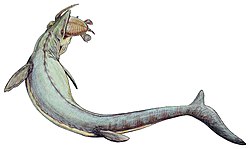Top Qs
Timeline
Chat
Perspective
Hornerstown Formation
Geological Formation in New Jersey From Wikipedia, the free encyclopedia
Remove ads
The Hornerstown Formation is a latest Cretaceous to early Paleocene-aged geologic formation in New Jersey. It preserves a variety of fossil remains, including those of dinosaurs, and contains direct evidence of the mass mortality that occurred at the Cretaceous-Paleogene boundary.[2][3][4]
Outcrops of the Hornerstown Formation are known from sites such as Edelman Fossil Park.[5]
Remove ads
Age & significance
Summarize
Perspective
The age of the Hornerstown deposits have been controversial. While most fossils are of animal taxa known from the earliest Cenozoic era, several fossils of otherwise exclusively Cretaceous age have been found. These include remains of the shark Squalicorax, several types of non-avian dinosaurs, the teleost fish Enchodus, several species of ammonite, and marine lizards referred to the genus Mosasaurus. Some of these remains show signs of severe abrasion and erosion, however, implying that they may be re-worked from older deposits. Most of these fossils are restricted to the lowest point in the formation, one rich in fossils and known as the Main Fossiliferous Layer, or MFL. Other explanations for the out-of-place fossils in the MFL is that they represent a time-averaged assemblage that built up and remained unburied during a time of low sediment deposition, or that they were stirred up from deeper in the sediment and deposited together during a tsunami.[6] Biochemical analyses done on mosasaur bones from the Hornerstown Formation and the underlying, purely Cretaceous New Egypt Formation have found differing chemical signatures in the content of rare earth elements depending on whether the bones derive from the New Egypt or the Hornerstown Formation. This provides evidence against the idea that the presence of these remains in the Hornerstown is just the result of reworking, and supports the Hornerstown Formation including Cretaceous strata.[7]
To account for these Cretaceous fossils, the Hornerstown Formation is generally treated as including the last portion of the Maastrichtian shortly before the Cretaceous-Paleogene boundary, and is thus divided into three sections: the section below the MFL (entirely Maastrichtian), the MFL itself (at the K-Pg boundary), and the section above the MFL (entirely Danian). However, other studies continue to treat the Hornerstown Formation as a Paleocene formation that saw significant reworking of Cretaceous fossils into itself.[8] In addition, recent studies have found evidence of high iridium concentration and shocked quartz within the MFL, suggesting that the MFL represents a thanatocoenosis formed from an ecosystem collapse during the Cretaceous-Paleogene extinction event. This makes the Hornerstown Formation one of the few geological formations to contain direct evidence of the immediate impact of the extinction event. The Hornerstown Formation is important paleontologically, as it shows the impact of the K-Pg extinction on the coastal waters of eastern Appalachia, contains many of the last known records of taxa that went extinct at the K-Pg boundary, while also providing evidence of survivorship for the taxa that managed to survive the extinction event.[3]
Remove ads
Vertebrate paleofauna
Summarize
Perspective
Cartilaginous fishes
Based on Case (1996) and Boles et al (2024):[3][9]
Chimaeras
Sharks
Rays
Ray-finned fishes
Reptiles
Birds
A number of fossil birds are known from the greensands of the formation. The Hornerstown serves as the type locality for all these genera and species:
Non-avian dinosaurs
The tyrannosauroid Dryptosaurus is sometimes referred to this formation, as its remains were found in the New Egypt Formation, which is sometimes considered a part of the Hornerstown.[15]
Crocodylomorphs
Plesiosaurs
Turtles
Mosasaurs
Remove ads
See also
References
Wikiwand - on
Seamless Wikipedia browsing. On steroids.
Remove ads







































